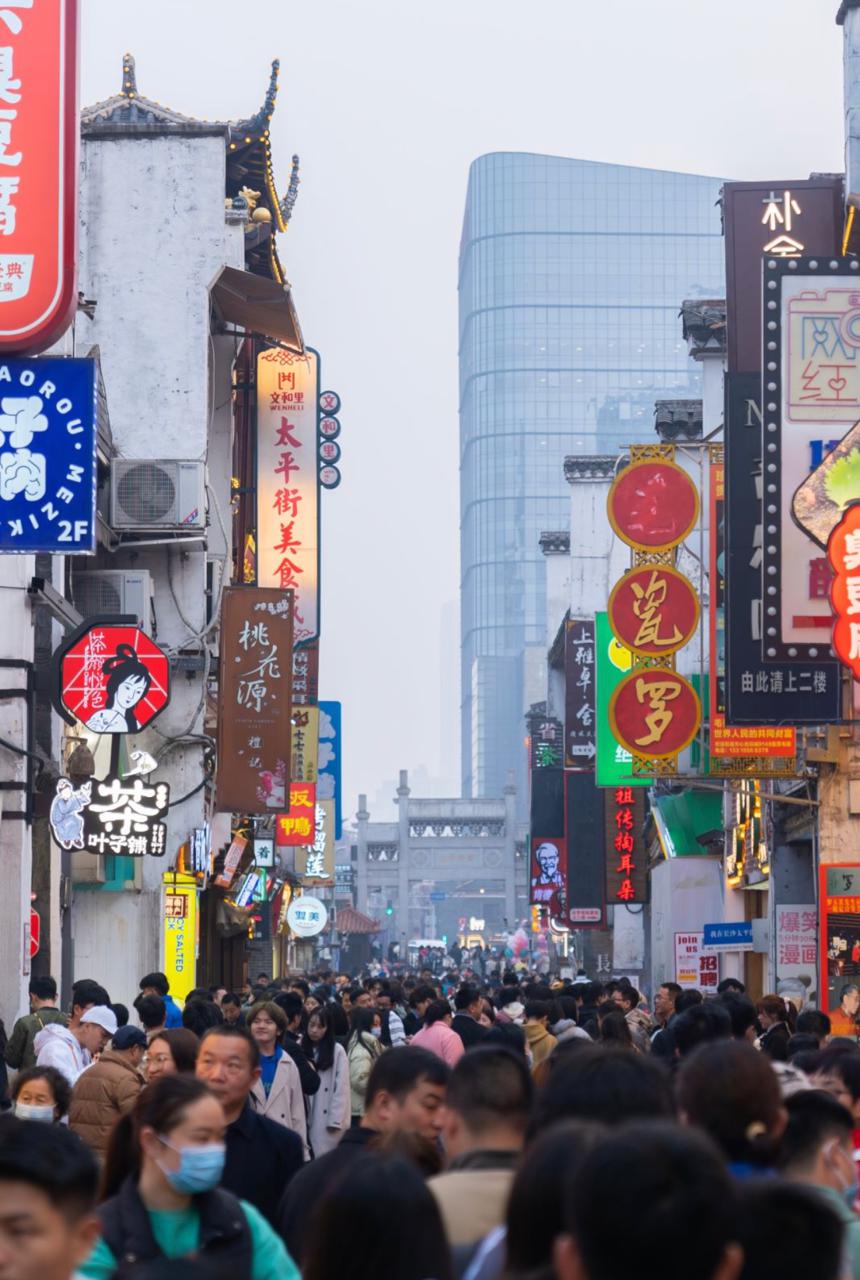Taiping Street as time machine to millennia ago
2023-04-17

The ancient street stretches from West Jiefang Road to Wuyi Avenue, two most bustling main roads in downtown Changsha. Amid continuous hawking on each side, one may find himself in the middle of ancient Changsha upon entering the bluestone arch building, with shoppers coming and going all the time.
Actually, the area has been the city center since ancient times. As time goes by, Taiping Street has been well preserved as a historical landmark, whose long history and prosperity can be suggested by Jia Yi’s Former Residence and an archaeological site unearthed recently.
Taiping Street features more than a long history. It boasts an assortment of street food along both sides with long lines. Yet the most delicious snack, though humble in appearance, may only be found in the solitary alleys, waiting for lucky treasure hunters.
If you want to explore the history of Taiping Street, enter it through the South Gate. A walk of dozens of meters may lead you to Jia Yi’s Former Residence.
Jia Yi was the chief executive in the Changsha Kingdom of the Western Han Dynasty (roughly corresponding to modern Hunan Province), so of course his residence was situated in Changsha’s heart, which suggests that Taiping Street has been the city center since the Qin and Han Dynasties at least.

Actually, the area has been the city center since ancient times. As time goes by, Taiping Street has been well preserved as a historical landmark, whose long history and prosperity can be suggested by Jia Yi’s Former Residence and an archaeological site unearthed recently.
Taiping Street features more than a long history. It boasts an assortment of street food along both sides with long lines. Yet the most delicious snack, though humble in appearance, may only be found in the solitary alleys, waiting for lucky treasure hunters.
If you want to explore the history of Taiping Street, enter it through the South Gate. A walk of dozens of meters may lead you to Jia Yi’s Former Residence.
Jia Yi was the chief executive in the Changsha Kingdom of the Western Han Dynasty (roughly corresponding to modern Hunan Province), so of course his residence was situated in Changsha’s heart, which suggests that Taiping Street has been the city center since the Qin and Han Dynasties at least.

Upon the ancient street with gray brick paths and tile-roofed buildings, one may feel as if he were traveling to ancient Changsha, as shops are all decorated with white tile ridge and wooden doors and windows. Along the street, food vendors are advertising their products over loudspeakers, while silver ornament sellers even move their workshops to the doorway for a better display of the production process.
Murals on white tile walls tell about the ancient people’s life and work.
Visitors may also come across an interesting phenomenon. Whenever someone passes by the construction site at the South Gate, he will tiptoe over the crowd to look around curiously for inside mystery.
The mystery turns out to be fairly complete courtyard remains from the Southern Song Dynasty, the earliest uncovered in urban Changsha. So far, the construction site has seen 22 building remains, 4 cooking stoves, 196 ash pits, 24 ditches, 15 wells and 2 road surfaces from the Song and Yuan to Ming and Qing dynasties, and well clusters in the Ming and Qing dynasties.
A cluster of ancient houses and wells reminds people of the bygone era when ancient locals, just like today’s, might walk through the crowded street, with hawkers’ voices lingering in their ears, all reflections of then prosperity.
Visitors may fail to enjoy all of Taiping Street’s deep and historic holdings in a short time, but they can immediately find happiness in food. For them, it is a paradise of delicacies.
Changsha earns the name of food capital for the attraction tour from Wuyi Road to West Jiefang Road to Taiping Street and to Super Wenheyou, a route linking up the city’s tasty snacks and dishes.
It is history that enables Taiping Street to tell a story, and the street food and shops add life’s flavor to it, thanks to which the story spanning over two millennia is and will be passed down.
Murals on white tile walls tell about the ancient people’s life and work.
Visitors may also come across an interesting phenomenon. Whenever someone passes by the construction site at the South Gate, he will tiptoe over the crowd to look around curiously for inside mystery.
The mystery turns out to be fairly complete courtyard remains from the Southern Song Dynasty, the earliest uncovered in urban Changsha. So far, the construction site has seen 22 building remains, 4 cooking stoves, 196 ash pits, 24 ditches, 15 wells and 2 road surfaces from the Song and Yuan to Ming and Qing dynasties, and well clusters in the Ming and Qing dynasties.
A cluster of ancient houses and wells reminds people of the bygone era when ancient locals, just like today’s, might walk through the crowded street, with hawkers’ voices lingering in their ears, all reflections of then prosperity.
Visitors may fail to enjoy all of Taiping Street’s deep and historic holdings in a short time, but they can immediately find happiness in food. For them, it is a paradise of delicacies.
Changsha earns the name of food capital for the attraction tour from Wuyi Road to West Jiefang Road to Taiping Street and to Super Wenheyou, a route linking up the city’s tasty snacks and dishes.
It is history that enables Taiping Street to tell a story, and the street food and shops add life’s flavor to it, thanks to which the story spanning over two millennia is and will be passed down.


